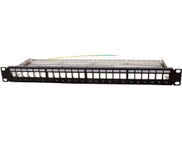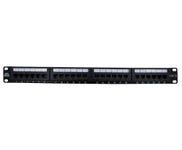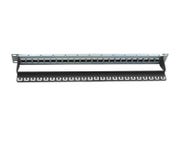Patch Panels
Browse and shop online our range of patch panels, available in shielded or unshielded and loaded or unloaded configurations to suit any network type. Our patch panels are designed to fit into standard 19 inch data and server racks, making installation and termination quick easy.
Our Cat6 patch panels are available with either removable keystone jacks or a PCB and can be terminated with either a Krone style or 110 punchdown tool.
-
 Hypertec 24 Port Loaded Cat6 Unshielded Patch PanelItem Number: HPC624PPackaging Unit: 1 / eachLoading price...
Hypertec 24 Port Loaded Cat6 Unshielded Patch PanelItem Number: HPC624PPackaging Unit: 1 / eachLoading price... $122.55
$122.55 -
 Hypertec 24 Port Unloaded Shielded Keystone Patch PanelItem Number: HPP24-USKPackaging Unit: 1 / eachLoading price...
Hypertec 24 Port Unloaded Shielded Keystone Patch PanelItem Number: HPP24-USKPackaging Unit: 1 / eachLoading price... $77.33
$77.33 -
 MSS 24 Port Loaded Category 6 Unshielded PCB Patch PanelItem Number: MSSPP246UPackaging Unit: 1 / eachLoading price...
MSS 24 Port Loaded Category 6 Unshielded PCB Patch PanelItem Number: MSSPP246UPackaging Unit: 1 / eachLoading price... $106.50
$106.50 -
 MSS Copper 24 Port Loaded Cat6A Shielded Patch PanelItem Number: MSSPP24C6ASPackaging Unit: 1 / eachLoading price...
MSS Copper 24 Port Loaded Cat6A Shielded Patch PanelItem Number: MSSPP24C6ASPackaging Unit: 1 / eachLoading price... $304.00
$304.00 -
 MSS Copper 24 Port Loaded Cat6A Unshielded Patch PanelItem Number: MSSPP24C6APackaging Unit: 1 / eachLoading price...
MSS Copper 24 Port Loaded Cat6A Unshielded Patch PanelItem Number: MSSPP24C6APackaging Unit: 1 / eachLoading price... $247.00
$247.00 -
 MSS Copper 24 Port Unloaded Unshielded Keystone Patch PanelItem Number: MSSPP24ULPackaging Unit: 1 / eachLoading price...
MSS Copper 24 Port Unloaded Unshielded Keystone Patch PanelItem Number: MSSPP24ULPackaging Unit: 1 / eachLoading price... $47.18
$47.18
Buy our Huge Range of Patch panel Online
What is a patch panel?
A patch panel is a hardware component used in computer networking, telecommunications, and audio-visual systems. Its primary purpose is to simplify cable management, facilitate troubleshooting, and provide a flexible means of connecting and rearranging cables without disrupting the entire network.
The patch panel acts as a termination point for cables coming from various locations, such as individual rooms, workstations, or other networking devices. Patch panels are commonly used in data centers, server rooms, and other environments where you need to manage a large number of connections.
Types of patch panel
On our website, MSS Data Solutions, you will find several kinds of patch panels, but in this section, we will discuss about the most common types of patch panels available in the market.
Ethernet Patch Panel
- Cat5e Patch Panel – This patch panel is used for Cat5e Ethernet cables, supporting data rates up to 1 Gbps.
- Cat6 Patch Panel – It is designed for Cat6 Ethernet cables, providing support for data rates of 1GB and up to 10 Gbps (over reduced distances).
- Cat6a Patch Panel – These are intended for Cat6a cables, supporting data rates up to 10 Gbps over longer distances.
Audio/Video Patch Panel
Audio/Video Patch Panels or AV Patch Panels are used in audio-visual setups for connecting video, audio, and other multimedia devices.
Fiber Optic Patch Panel
- Multimode Fiber Optic Patch Panel – These are designed for shorter-distance, high-bandwidth applications over multimode fiber optic cables.
- Single-Mode Fiber Optic Patch Panel – These patch panels are used for long-distance, high-bandwidth applications over single-mode fiber optic cables.
High-Density Patch Panel
It is a handy patch panel that accommodates many ports in a compact space. So, you can use this patch panel where the space is limited.
Shielded/Unshielded Patch Panel
- Unshielded Patch Panel - Unshielded Patch Panels (UTP) are components used in networking and telecommunications infrastructure designed to organize and manage unshielded twisted pair (UTP) cables.
- Shielded Patch Panel - The shielded patch panel is designed to provide protection against electromagnetic interference. It is important in environments with high EMI, such as industrial settings or areas with a lot of electronic equipment.
Function of Patch Panel
The main functions of Patch Panels are:
- Structured Cabling – Patch panels facilitate organized and structured cabling by providing a designated and labelled port for each cable. This organization makes it easy to identify and manage specific connections.
- Acts as a termination point - Patch panels act as a termination point for cables coming from various locations, such as individual rooms, workstations, or other networking devices. These incoming cables are terminated on the back of the patch panel.
- Maintenance and Troubleshooting – In the event of connectivity issues, patch panels simplify the troubleshooting process. Network administrators can trace problems to specific ports on the patch panel and eventually address issues without disrupting the entire network.
- Maintaining Signal Integrity - Properly terminated and organized cables at the patch panel maintain signal quality and reduce the risk of interference, ensuring reliable data transmission.
What does a patch panel do?
In this section, we will mention the working mechanism of a patch panel.
- Termination of Cables - Cables from different rooms, areas, or devices are terminated onto the back of the patch panel. This termination involves attaching the individual conductors of each cable to specific ports on the panel.
- Port Labelling – Ports on the patch panel are usually labelled or numbered. This labelling helps to identify and organize the connections, making it easier for network administrators to manage and troubleshoot the network.
- Connection to Devices - The front side of the patch panel is accessible and usually features a set of ports corresponding to those on the back. Network devices, such as computers, servers, routers, or switches, can then be connected to these front ports using short patch cables.
- Patch Cables - Short patch cables connect the patch panel's front ports and the devices' ports. These patch cables are pre-designed with connectors on both ends and are available in various lengths.
How to use a patch panel
If you want to use a patch panel properly, follow the steps given below:
- Terminating Cables onto the Patch Panel
- Prepare the Cables - Ensure that the network cables are properly prepared. It includes stripping the outer insulation and untwisting the pairs of wires according to the specified termination standard (e.g., T568A or T568B for Ethernet).
- Termination - Terminate each cable onto the back of the patch panel. It involves inserting the individual conductors of each cable into the corresponding ports on the back of the patch panel and securing them using a punch-down tool.
- Labeling – You need to label the cables at both ends. This step helps to identify the cables and makes it easier to manage and troubleshoot the network.
- Making Connections on the Front Side
- Device Connection - Connect network devices (e.g., computers, servers, switches) to the front ports of the patch panel using short patch cables.
- Labelling on the Front - If the front side of the patch panel is not pre-labelled, label the front ports to correspond with the devices or rooms connected. It helps to identify and manage the connections properly.
- Cable Management
- Use Cable Organizers – Always use cable organizers, if available, to keep the cables neat and well-organized. Proper cable management helps prevent tangles, reduces the risk of human error, and contributes to a clean and efficient network setup.
Patch panel buying guide
Before deciding to buy patch panel online, consider the following factors:
- Number of Ports - Consider the number of ports you need on the patch panel. Choose a patch panel with enough ports to accommodate your current needs.
- Compatibility - Ensure the patch panel is compatible with your cable type and category (e.g., Cat5e, Cat6, Cat6a). Furthermore, check if it supports your termination standards (T568A, T568B).
- Port Density - Port density refers to the number of ports in a given physical space. High-density patch panels are suitable for environments where space is limited.
- Type of Patch Panel - Determine the type of patch panel you need and eventually go for the most appropriate one to get the best result.
- Shielded or Unshielded - Choose shielded (STP) or unshielded (UTP) patch panels based on your cabling requirements and the level of electromagnetic interference in your environment.
- Proper Future Planning – You must correctly anticipate your future needs and network growth before purchasing a patch panel. Eventually, choose a patch panel that allows easy expansion and upgrades.
Buy Patch Panel Online in Australia from MSS Data Solutions
You can check out our website, MSS Data Solutions, to buy patch panels online, as our website has a vast range of patch panels. We even sell our products at a cheap rate so a large number of customers can purchase the products even if they have money constraints.
MSS Data Solutions delivers its products all over Australia. MSS Data Solutions patch panels have undergone rigorous testing to meet or exceed industry standards, ensuring durability and performance.
Your ordered quantity for this item is more than what we have in stock.
Stock Availability
| Location | |
|---|---|
Please contact us to know more about this item's availability or possible restock dates.

